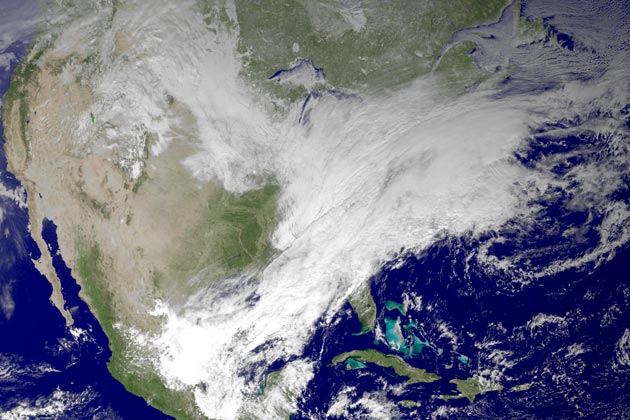
Why Is It So Cold? The Polar Vortex, Explained
By Eric Roston January 07, 2014
“Polar vortex” has taken an uncontested lead in the competition for buzzword of 2014. It’s brought Arctic chill to the continental United States, disrupted industries and cities, and most, curiously, turned Donald Trump into a climate realist. Sort of.
Here’s a thought. What if Trump is right? An alternative, charitable reading of the tweet reveals Trump to be an impassioned climate change policy advocate with up-to-date knowledge of peer-reviewed science as it relates to our current cryogenic state.
After all, global warming is expensive and growing more so. And, as weird as it sounds, global warming can play an indirect role in the occasional deep freeze.
The Arctic is heating faster than the rest of the world, hurried along by the disappearance of polar sea ice. Bright white ice reflects energy back into space; dark blue water absorbs it. Arctic temperatures are about 2 degrees Celsius warmer there than they were in the mid-1960s. (The average temperature increase for the Earth’s atmosphere overall is about 0.7 degree C, since 1900.)
In other words, the temperature difference between the Arctic and North America is shrinking. That’s one factor causing wobbliness in the jet stream, the west-east current that circles the Northern Hemisphere, according to Jennifer Francis, research professor at Rutgers University. Normally, that river of air keeps low-pressure cold air contained above the Arctic and holds higher-pressure warm air above the temperate regions, where most people live.
Scientists tend to call the jet stream a “polar vortex,” Francis says.
A slowing in the jet stream has caused it to zigzag, carrying warmer temperatures farther north than usual—and Arctic cold farther south. “The real story,” Francis says, is that the jet stream is “taking these big swings north and south and that’s causing unusual weather to occur in a number of places around the Northern Hemisphere.”
If New York is too cold, try Fairbanks or St. Petersburg, which have experienced weird highs as 2013 came to a close—or, for snowbirds, Australia, which just concluded its hottest year on record, a smoldering 1.2 degrees C (2.1 degrees Fahrenheit) above average.
Temperatures will return to more typical winter cold later this week, and “polar vortex” will retreat from headlines. Meanwhile, the best answer to any statement like, “the polar vortex disproves global warming,” is a polite smile.
“Global warming” is too narrow a term to encompass observed and projected changes to rivers, oceans, forests, cities and weather extremes, and “climate change” includes a much wider variety of events than hotter temperature averages and extremes—increasing rain and snow, increasing droughts and floods, more powerful and frequent tropical storms, reduced cloud cover, and so forth.
Better yet, call it what some geologists are beginning to call it, the Anthropocene, or human epoch, a departure from the Earth’s operating system—the first in almost 12,000 years.


































